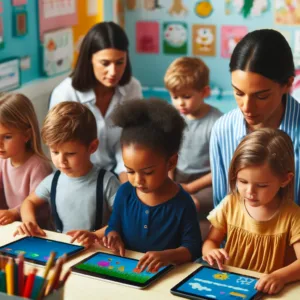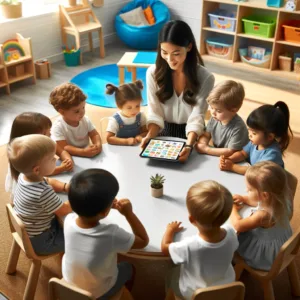Early Childhood Education Guide for Parents
In an era where digital devices are ubiquitous, the question of how early childhood education can harness technology effectively is more relevant than ever, especially for parents in the Table View community. As children become increasingly exposed to technology at younger ages, it’s essential to understand how to integrate these tools in ways that enhance learning without overshadowing fundamental developmental needs.

The Role of Technology in Early Childhood Education
Technology, when used appropriately, can be a powerful ally in the developmental and educational processes of young children. From interactive apps that teach basic maths and language skills to e-books that make storytime more engaging, technology offers diverse benefits. However, striking the right balance is key to ensuring that technology serves as a complement to traditional learning methods, rather than a replacement.
Understanding the Appropriate Age for Technology Integration
The consensus among educators and psychologists is that technology should be introduced once children can benefit from it, which typically aligns with preschool ages. Before introducing any digital device or media, it’s crucial that the child has reached an age where they can interact with technology in a meaningful way. For toddlers and preschoolers in Table View, this means supervised use of technology with a clear educational purpose.
Benefits of Technology in Preschool Education
The incorporation of technology in early childhood education brings a host of benefits that can significantly enhance the learning experience and development of young children. As technology evolves, it offers fresh, dynamic, and interactive ways to engage preschool-aged children in learning activities that can spark their curiosity and aid in various developmental areas. Here, we delve deeper into these advantages, underscoring why technology is becoming an integral part of early childhood education.
Enhanced Learning Engagement
One of the most observable benefits of technology in preschool settings is the heightened level of engagement among young learners. Children are naturally drawn to screens, but when this fascination is directed towards educational content, their engagement can lead to better learning outcomes. Digital tools like tablets, smartboards, and educational apps can transform traditional learning materials into interactive experiences that captivate children’s attention. For example, an app that teaches phonics can turn a routine lesson into a fun game with characters, sounds, and rewards. The multi-sensory engagement provided by such tools supports better retention of information and motivates learners by making learning enjoyable.
Access to a World of Information
Technology acts as a gateway to a vast array of information that can be tailored to the learning needs of each child. Interactive apps and websites provide access to endless educational content, from storytelling videos that improve language skills to online puzzles that develop mathematical thinking. This ready access encourages children to explore new concepts at their own pace and deepens their understanding through repetition and practice, which can be adjusted to match their individual learning speed and preferences.
Development of Essential Skills
Integrating technology in preschool education also aids in developing essential skills that are crucial in the digital age. These include digital literacy and problem-solving skills. Children learn to navigate interfaces, understand multimedia content, and interact with digital devices, skills that are indispensable in today’s tech-driven world. Furthermore, many educational technologies are designed to develop critical thinking and problem-solving skills through activities that require children to make decisions, solve puzzles, or complete tasks, thereby enhancing their cognitive abilities.
Personalised Learning Experiences
Technology enables personalised learning, where educational content can be customised to suit the learning styles and paces of individual children. Adaptive learning technologies can assess a child’s current skill level and automatically adjust the difficulty of tasks to provide just the right challenge. This personalization helps maintain an optimal learning curve and prevents children from feeling either under-challenged or overwhelmed. Personalised feedback provided by educational software can also guide children through learning paths that are best suited to their unique needs, promoting more effective learning outcomes.
Fostering Collaboration and Social Skills
While technology is often criticised for isolating users, when used effectively in preschools, it can foster collaboration and enhance social skills. Many educational games and platforms are designed for multiple players, encouraging children to work together to solve problems or complete projects. This collaborative use of technology teaches children how to communicate ideas, share resources, and support each other’s learning. Additionally, technology-based group activities can help children learn to negotiate roles, take turns, and respect others’ contributions, which are essential social skills.
Supporting Teachers and Parents
Technology also supports educators and parents in tracking and enhancing early childhood education. Educational apps and software often come with analytics features that provide insights into a child’s progress, strengths, and areas needing improvement. This data can be invaluable for teachers planning personalised instruction and for parents seeking to understand and support their children’s learning journeys. Moreover, technology can help bridge the home-school gap, as parents can access apps or platforms used in school settings, allowing them to engage directly with their children’s education.
The integration of technology in early childhood education offers a spectrum of benefits that can enrich the educational landscape and prepare children for the future. From enhancing engagement and accessibility to fostering essential digital and social skills, technology holds the potential to transform early learning experiences. However, it is crucial to balance technology use with traditional learning and ensure that digital tools are used as effective supplements to holistic educational approaches, always keeping the developmental needs of children in the forefront.

Guidelines for Integrating Technology in Childcare Settings
For childcare providers and pre-primary schools, the integration of technology requires careful planning:
- Limit Screen Time: According to child development experts, screen time should be limited, and always supervised. Interactive screen time should not replace physical play, crafts, or reading time.
- Choose Appropriate Content: Ensure that the content is educational and appropriate for the child’s age. There are numerous apps and digital resources designed specifically for early childhood education that can be both fun and beneficial.
- Encourage Interactive Participation: Technology should be used as a tool to enhance interaction, not isolate children. Apps that encourage problem-solving, critical thinking, and creative expression are preferable.

Community Resources in Table View
Table View is home to various resources for parents interested in integrating technology into early childhood education:
- Local Libraries and Community Centres: These often offer workshops and seminars on digital literacy and how to integrate technology into early learning.
- School Initiatives: Many local schools have begun to incorporate digital tools in their classrooms and often have guidelines and resources for parents looking to do the same at home.
Integrating technology into early childhood education requires a thoughtful approach that prioritises the developmental needs of children. By understanding the appropriate uses of technology and utilising local resources, parents can ensure that their children not only become proficient with digital tools but also grow and learn in a balanced environment.
We invite all Table View parents to explore more about technology in early childhood education and to join us in discussions and forums that help foster a community well-versed in the benefits and challenges of digital learning. Together, we can guide our children towards a fruitful educational journey complemented by technology.

